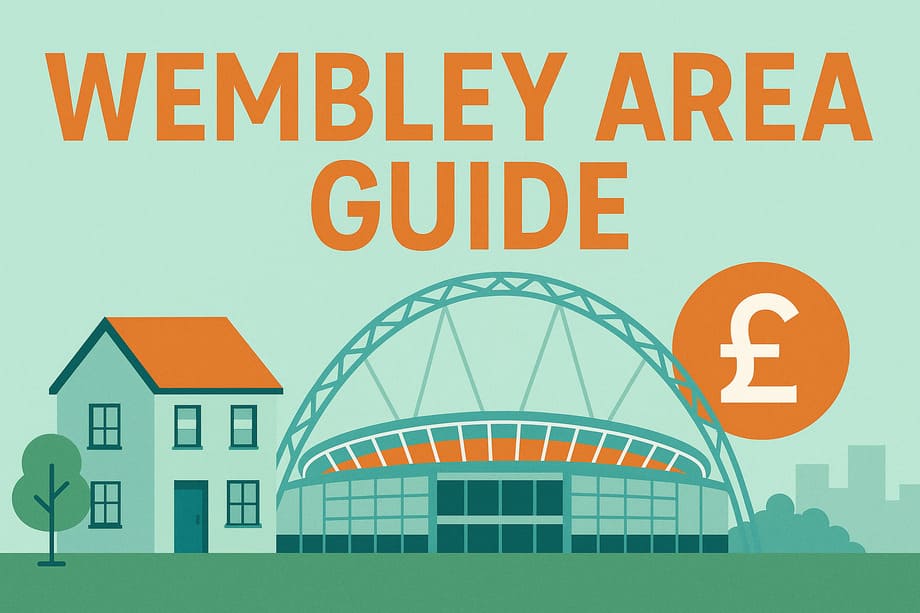Living in Wembley Area Guide – Your Complete Guide to London’s Iconic Stadium District

1. Introduction to Wembley
Nestled in the heart of northwest London, Wembley stands as one of the capital’s most recognizable boroughs, synonymous with sporting excellence and cultural vibrancy. This dynamic area has transformed dramatically over recent decades, evolving from a suburban district into a thriving urban hub that attracts residents, visitors, and investors from across the globe.
The crown jewel of any Wembley area guide is undoubtedly the world-famous Wembley Stadium, home to England’s national football team and host to countless legendary sporting events and concerts. However, Wembley London offers far more than its iconic twin towers might suggest. The area boasts remarkable cultural diversity, with vibrant South Asian communities creating a rich tapestry of traditions, cuisine, and festivals that make this corner of London truly unique.
Positioned strategically within Zone 4 of London’s transport network, Wembley provides an attractive balance between accessibility to central London and the space to breathe that many inner-city areas lack. The postcodes HA0 and HA9 encompass a variety of neighborhoods, each with its own distinct character, from the bustling commercial areas around Wembley Central to the quieter residential streets of Alperton and Preston.
2. Is Wembley Good for Families?
When considering whether Wembley is good for families, the answer largely depends on your priorities and lifestyle preferences. This area offers several compelling advantages for family life, though like any London borough, it comes with certain considerations.
Educational Excellence
Wembley schools consistently rank among the better performers in the region, making it an attractive destination for families prioritizing education. The area boasts several outstanding primary schools, including Wembley Primary School and Mount Stewart Infant School, both rated ‘Good’ or ‘Outstanding’ by Ofsted. For secondary education, families have access to well-regarded institutions such as Alperton Community School and JFS School, which consistently deliver strong academic results.
The diversity of Wembley schools reflects the area’s multicultural population, with many institutions celebrating and incorporating different cultural traditions into their curriculum. This cultural richness provides children with valuable exposure to different perspectives and languages from an early age.
Safety and Community Feel
Safety remains a primary concern for families considering any London area. Wembley generally maintains lower crime rates compared to inner London boroughs, though certain areas require more caution than others. The residential streets away from the stadium and main commercial areas tend to be quieter and more family-friendly, with strong community ties and neighborhood watch schemes operating in many locations.
Green Spaces and Recreation
Despite its urban setting, Wembley offers numerous parks and recreational facilities perfect for families. King Edward VII Park provides excellent playground facilities and open spaces for children to play safely. Fryent Country Park, spanning over 260 acres, offers hiking trails, wildlife spotting opportunities, and outdoor education programs that many local schools utilize.
The proximity to Wembley Stadium also means access to various sporting facilities and events, though families should be prepared for the increased crowds and noise on event days.
3. Cost of Living & Rent in Wembley
Understanding the Wembley cost of rent and overall living expenses is crucial for anyone considering making this area their home. The property market in Wembley presents a mixed picture, with significant variations depending on exact location and property type.
Rental Market Overview
Living in Wembley typically costs less than central London areas, making it an attractive option for those seeking better value for money. Current market rates show one-bedroom flats ranging from £1,200 to £1,600 per month, while two-bedroom properties typically cost between £1,500 and £2,200 monthly. Three-bedroom family homes command between £2,000 and £3,000 per month, depending on condition and exact location.
Properties closer to Wembley Stadium command premium rents due to their proximity to transport links and entertainment facilities. However, those willing to walk an extra ten minutes can often find significantly better value in the quieter residential streets surrounding the main commercial areas.
Stadium Proximity Premium
The Wembley cost of rent varies considerably based on proximity to the stadium and major transport hubs. Properties within a five-minute walk of Wembley Central or Wembley Park stations typically cost 15-20% more than comparable properties in areas like Alperton or Preston. This premium reflects not just transport convenience but also the regeneration efforts that have improved infrastructure and amenities in the immediate stadium vicinity.
Additional Living Costs
Beyond rent, living in Wembley offers reasonable costs for daily necessities. The area’s diverse population supports numerous budget-friendly supermarkets, including several large Tesco and ASDA stores, alongside smaller ethnic grocery shops offering specialty ingredients at competitive prices. Council tax falls within Brent’s rates, which are moderate compared to other London boroughs.
Utilities and internet costs align with London averages, though residents should budget for slightly higher heating costs in older Victorian terraces that are common throughout the area.
4. Transport Links and Commuting from Wembley
Wembley transport links represent one of the area’s strongest selling points, offering multiple options for reaching central London and beyond. The comprehensive transport network makes commuting from Wembley both practical and relatively affordable compared to many other outer London areas.
Underground Connections
The London Underground provides the backbone of Wembley’s transport infrastructure. Wembley Park station sits on both the Jubilee Line and Metropolitan Line, offering direct connections to central London locations including Bond Street, Westminster, and London Bridge. Journey times to Oxford Circus typically range from 20-25 minutes, making it feasible for residents to work in the West End while enjoying the space and value that Wembley provides.
Wembley Central station offers Metropolitan Line services, connecting directly to destinations including Baker Street, King’s Cross, and Liverpool Street. The Metropolitan Line’s express services during peak hours significantly reduce commuting times to the City of London.
Overground Services
London Overground services from Wembley Central provide additional connectivity, particularly useful for reaching areas not directly served by the Underground network. These services connect to Euston, offering easy access to national rail services for those requiring regular travel outside London.
Bus Network
An extensive bus network complements the rail services, with numerous routes connecting Wembley to neighboring areas including Harrow, Ealing, and Kilburn. Night bus services ensure residents can travel safely after hours, particularly important given the area’s entertainment venues.
Future Transport Developments
Planned transport improvements, including potential Crossrail connections and enhanced bus services, promise to further improve Wembley transport links over the coming years. These developments are likely to increase property values and make the area even more attractive for commuters.
5. Things to Do in Wembley: Entertainment and Activities
Discovering things to do in Wembley reveals an area rich in entertainment options, cultural experiences, and recreational activities that extend far beyond its famous stadium. The diverse community has created a vibrant local scene that caters to various interests and age groups.
Iconic Venues and Entertainment
Wembley Stadium dominates the entertainment landscape, hosting everything from England football matches to major concerts by international artists. The venue’s events calendar ensures regular excitement, though residents should prepare for the crowds and transport disruption that major events bring.
The London Designer Outlet provides year-round shopping entertainment, featuring over 50 stores offering designer brands at reduced prices. Beyond shopping, the outlet houses numerous restaurants, cafes, and a cinema complex, creating a comprehensive entertainment destination.
Cultural Experiences
The Wembley nightlife scene reflects the area’s cultural diversity, with establishments ranging from traditional British pubs to authentic Indian restaurants and modern cocktail bars. Ealing Road, known as London’s “Little India,” offers an incredible selection of South Asian restaurants, sweet shops, and cultural centers that provide insight into the area’s rich heritage.
Regular cultural festivals and community events take place throughout the year, celebrating the various communities that call Wembley home. The annual Diwali celebrations and Eid festivals create vibrant street celebrations that welcome participants from across London.
Recreational Activities
Beyond commercial entertainment, Wembley offers numerous recreational activities for residents of all ages. The Valley Farm Sports Centre provides swimming pools, fitness facilities, and organized sports clubs. Several local football clubs offer opportunities for both children and adults to participate in organized sports.
The nearby Welsh Harp Reservoir provides water sports opportunities, including sailing and fishing, while the surrounding parkland offers excellent walking and cycling routes that provide peaceful escapes from urban life.
6. Pros and Cons of Living in Wembley
Making an informed decision about relocating to any area requires honest assessment of both advantages and potential drawbacks. Living in Wembley offers numerous benefits alongside certain challenges that prospective residents should carefully consider.
Advantages of Wembley Living
Transport Excellence: The multiple transport connections make Wembley one of the best-connected outer London areas, with quick access to central London and reasonable commuting times to most business districts.
Cultural Richness: The area’s diversity creates an incredibly rich cultural environment, with authentic cuisine, festivals, and traditions from around the world readily accessible.
Value for Money: Compared to inner London areas, Wembley offers significantly better value for money in terms of both rental costs and property purchases, while still maintaining good transport links.
Entertainment Hub: Living near Wembley Stadium means access to world-class entertainment events, while the general area offers diverse dining, shopping, and nightlife options.
Educational Opportunities: Strong schools and educational facilities make the area particularly attractive for families prioritizing children’s education.
Potential Drawbacks
Event Day Disruption: Major events at Wembley Stadium can create significant crowding, noise, and transport delays that affect daily life for residents in the immediate vicinity.
Urban Density: While offering good value, some areas of Wembley can feel quite dense and busy, particularly around transport hubs and commercial centers.
Limited Green Space: Despite having some parks, Wembley offers less green space per capita than many other outer London areas, which may concern those prioritizing outdoor space.
Parking Challenges: On-street parking can be extremely difficult, particularly during events, and residents may need to budget for private parking arrangements.
Noise Levels: The combination of busy transport links, commercial activity, and regular events can create higher noise levels than some suburban alternatives.
Final Considerations
Wembley represents an excellent choice for those seeking the energy and convenience of London living without the premium costs of central areas. The area particularly suits young professionals, families prioritizing good schools and transport links, and those who appreciate cultural diversity and entertainment options.
However, those seeking quiet suburban life or extensive green spaces might find better alternatives in outer London’s more residential boroughs. The key lies in understanding your priorities and visiting the area at different times, including during major events, to experience the full reality of Wembley living.
The area’s continued development and transport improvements suggest strong long-term prospects, making it an increasingly attractive option for both renters and property investors looking at London’s evolving landscape.
Last Updated on August 21, 2025 by James Cartwright







